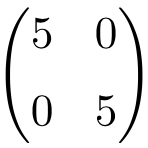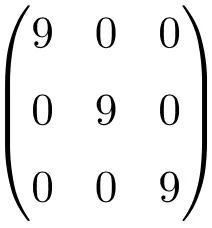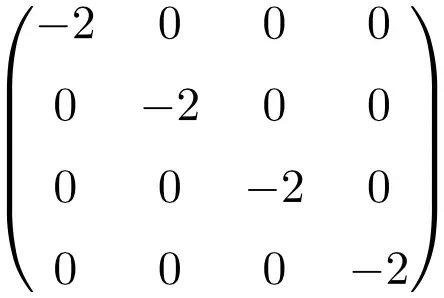On this post you will find what a scalar matrix is and several examples of scalar matrices. Also, you will see all the properties of the scalar matrix and the advantages of doing operations with it. Finally, we explain how to calculate the determinant of a scalar matrix and how to invert this type of matrix.
Table of Contents
What is a scalar matrix?
The definition of scalar matrix is as follows:
A scalar matrix is a diagonal matrix in which all the values on the main diagonal are equal.
Examples of scalar matrices
Once we’ve seen the meaning of scalar matrix, let’s see several examples of scalar matrices to fully understand the concept:
Example of a 2×2 scalar matrix

Example of a 3×3 scalar matrix

Example of a 4×4 scalar matrix

Properties of scalar matrices
The characteristics of the scalar matrix are as follows:
- All scalar matrices are also symmetric matrices.
- A scalar matrix is an upper triangular matrix and lower triangular matrix at the same time.
- The identity matrix is a scalar matrix.
- Any scalar matrix can be obtained from the product of an identity matrix and a scalar number.
- The zero matrix is a scalar matrix as well.
- The eigenvalues of a scalar matrix are the elements of its main diagonal. Thus, its eigenvalues will always be the same and will be repeated as many times as the dimension of the matrix.
- The adjoint (or adjugate) of a scalar matrix is another scalar matrix. Moreover, the values on the main diagonal of the adjugate matrix will always be those of the original matrix raised to the order of the matrix – 1.
➤ See: adjoint of a matrix
Operations with scalar matrices
One of the reasons scalar matrices are so widely used in linear algebra is the ease with which they allow you to perform calculations. This is why they are so important in math. Let’s see why it is so easy to do calculations with this type of square matrix:
Addition and subtraction of scalar matrices
The addition (and subtraction) of two scalar matrices is very simple: you just have to add (or subtract) the numbers of the main diagonals. For example:
Multiplication of scalar matrices
Similarly to addition and subtraction, to solve a multiplication or a matrix product between two scalar matrices, you only have to multiply the elements of the diagonals with each other. For example:
Power of scalar matrices
The calculation of the power of a scalar matrix is also very easy: we have to raise each element of the diagonal to the exponent. For example:
Determinant of a scalar matrix
The determinant of a scalar matrix is equal to the product of the elements on the main diagonal.
Look at the following solved problem in which we find the determinant of a scalar matrix by multiplying the elements of its main diagonal:
In fact, as all the elements on the main diagonal of a scalar matrix are always equal, to find the result of the determinant we only have to raise the number of the main diagonal by the number of times it is repeated. Therefore, the previous exercise can also be solved as follows:
To prove this theorem we only have to calculate the determinant of a scalar matrix by cofactors:
In this case the determinant results in because the matrix is of order 3, but we must always raise it to the order of the matrix.
Inverse of a scalar matrix
A scalar matrix is invertible if, and only if, all elements on the main diagonal are different from 0.
Also, the inverse of a scalar matrix will always be another scalar matrix with the reciprocals of the numbers on the main diagonal:
From the properties of determinants of matrices it can be deduced that the determinant of an inverted scalar matrix is the result of multiplying the reciprocals of the elements on the main diagonal: